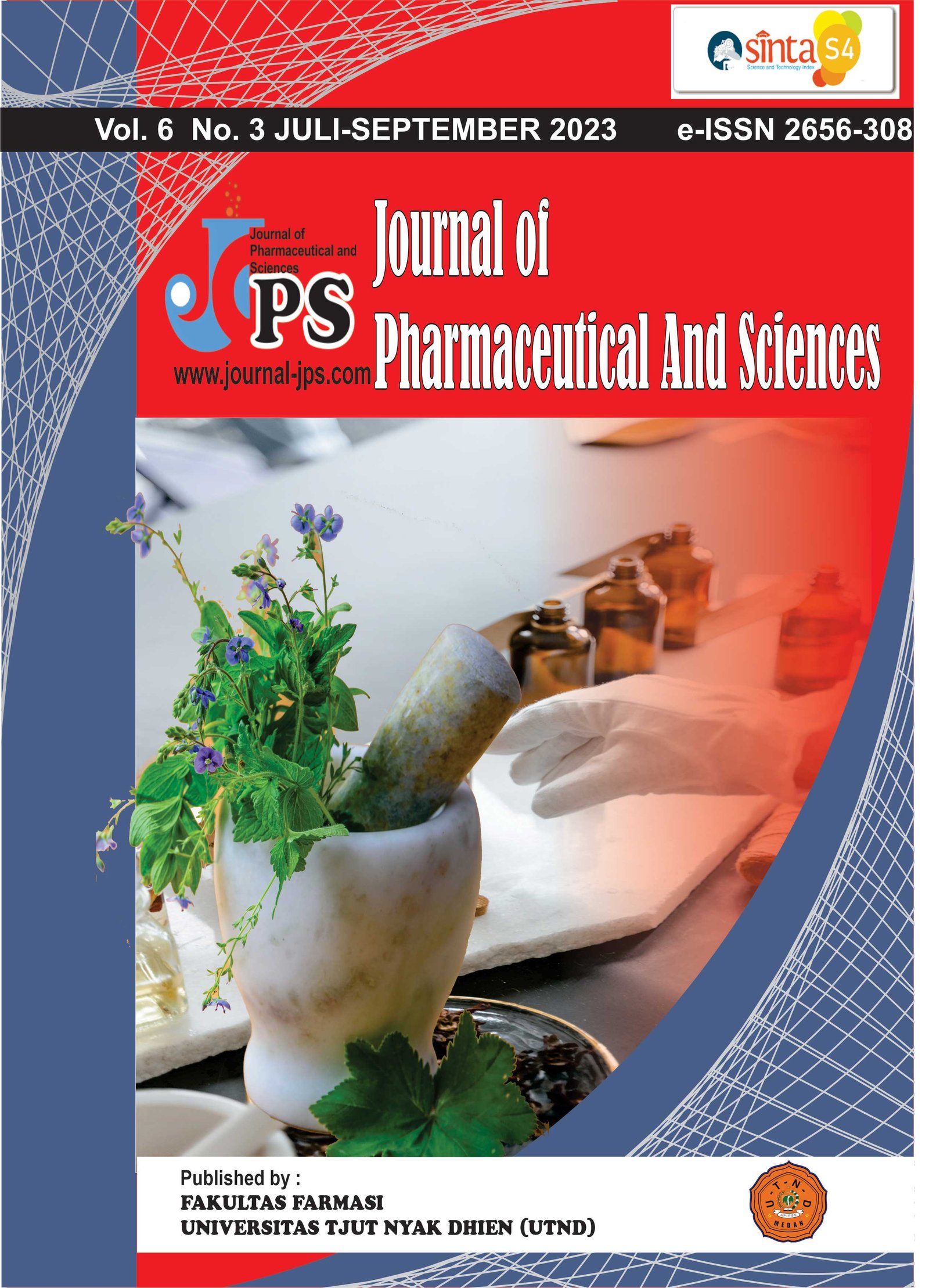Determination of total flavonoid ethanol extract of jasmine leaf (Jasminum sambac (L.) Sol. ex Aiton) using spectrophotometric Uv-Vis method
Main Article Content
Page: 1434-1442
Abstract
Traditional medicine uses plants with a natural ingredient content as its raw material. The bioactive compounds found in plants are secondary metabolites such as alkaloids, flavonoids, tannins, glycosides, steroids, and saponins. One of the plants containing secondary metabolite compounds is jasmine. This study aims to determine the chemical compounds contained in the ethanol extract and the total flavonoid content of the ethanol extract of jasmine leaves using the UV-Vis spectrophotometric method. The stages of this research included processing plant simplicia, making ethanol extract, examining characteristics, screening phytochemicals, and determining the total flavonoid content of the ethanol extract of jasmine leaves using the UV-Vis spectrophotometric method. Extract jasmine flower leaves by maceration method using 96% ethanol solvent; the extract obtained was concentrated using a rotary evaporator; then the total flavonoid content was determined using the UV-Vis spectrophotometry method. The research shows that the ethanol extract of jasmine flower leaves (Jasminum sambac (L.) Sol. ex Aiton) contains several secondary metabolite compounds, such as flavonoids, glycosides, alkaloids, saponins, steroids, and tannins. A number of steps were taken to find out how many flavonoids were in the ethanol extract as a whole. These included finding the maximum wavelength of quercetin, the operational time, making a quercetin calibration curve, and using UV-Vis spectrophotometry to determine how many flavonoids were in the extract. The analysis results reveal that the total flavonoid content in the ethanol extract of jasmine flower leaves is approximately 40.10911 ± 0.5878 mg QE/g.
Downloads
Article Details

This work is licensed under a Creative Commons Attribution-NonCommercial-ShareAlike 4.0 International License.
References
Al-Snafi, AE (2018). A review of the pharmacological and therapeutic effects of Jasminum sambac-A. Indo-American Journal of Pharmaceutical Sciences, 5 (3), 1766 - 1778.
Aminah., Tomahayu and Abidin, Z. (2017). Penetapan Kadar Flavonoid Total Ekstrak Etanol Kulit Buah Alpukat (Persea Americana Mill) Dengan Metode Spektrofotometri Uv-Vis. Jurnal Fitofarmaka Indonesia., Vol. 4, No.1
Chang, C, C., Y, M, H., Wen, H, M., and Chern, J, C. (2002). Estimation of total flavonoid content in propolis by two complementary colorimetric methods. J Food Drug Analysis, 3 (10), Hal. 178 - 182.
Charisma Acivrida Mega., Farida Anwari, E.A.F., and K.I.W. (2021). Pemberdayaan Masyarakat dalam Penanaman Tanaman Melati (Jasminum Sambac) Sebagai Larvasida Alami untuk Pencegahan Demam Berdarah Dengue (DBD) di Desa Lebakjabung Kec. Jatirejo Kab. Mojokerto. Jurnal Prosiding Seminar Nasional Abdimas Ma Chung. pp., 420 - 428.
Depkes RI. (1989).Materia Medica Indonesia (Jilid V). Departemen Kesehatan Republik Indonesia.
Geissman, TA. (1962). The Chemistry of Flavonoid Compound. Pergamon Press Oxford.
Haeria, Hermawati, A.T.U.D.P. (2016). Penentuan Kadar Flavonoid Total dan Aktivitas Antioksidan Ekstrak Etanol Daun Bidara (Ziziphus spina-christi L.). Journal of Pharmaceutical and Medicinal Sciences Fakultas Kedokteran dan Ilmu Kesehatan UIN Alauddin Makassar, Makassar Indonesia, 1 (2) : 57 - 61.
Haris, M. (2011). Penentuan Kadar Flavanoid Total dan Aktivitas Antioksidan Dari Daun Dewa (Gynura pseudochina [Lour] DC) Dengan Spektrofotometer UV-Vis. Skripsi. Fakultas Farmasi. Universitas Anadalas. Padang.
Kapse, K., & Goyal, S. (2021). Chemical Constituents from Different Extracts of Leaves of Jasminum Sambac for Their Antioxidant Activity. Plant Archives, 20 (2), 4366 - 4373.
Kelly, S G. (2011). Alternativ Medicine Review. Journal Quersetin., 16 (2).
Krishnaveni. A.S.R.T. (2014). Free Radical Scavenging Activity of Jasminum Sambac. Journal of Global Trends in Pharmaceutical Sciences, 5 (2), 1658 – 1661.
Kunhachan, P.,C. Banchonglikitkul, T.K., and Leelamanit, A.K. and W. (2012). Chemical composition, toxicity, and vasodilatation effect of the Jasminum sambac (L.) Ait flowers extract. “G. Duke of Tuscany.” Journal of Evidence-Based Complementary and Alternative Medicine, 1 (4), 1 – 7.
Mursito, B. (2001). Sehat Diusia Lanjut dengan Ramuan Tradisional. Penebar Swadaya.
Perdanakusuma D. S. (2007). Anatomi fisiologi kulit dan penyembuhan luka. Journal. Airlangga University School of Medicine., 5 – 7.
Rais IR. (2015). Solation and Determination of Flavonoid Content of (Andrographis paniculata (Burm.f.) ness) Ethanolic Herb Extract. Pharmaciana., 5 (1) :, 101 – 106.
Sari, E. K., Purwati, E., Ikhda, C., Hamidah, N., and Novianandra, E. (2022). Uji Aktivitas Antibakteri Ekstrak Daun Melati (Jasminum sambac) Terhadap Bakteri Propionibacterium acnes. Jurnal Farmasi Indonesia, III (April), 43 – 52.
Suryowinoto, S.M.. (1997). Flora Eksotika Tanaman Hias Berbunga. Kanisius.
Widowati.. (2016). Uji Kandungan Fitokimia dan Uji Aktivitas Antioksidan, Antielastase, Antikolagenase Ekstrak Bunga Melati (Jasminum sambac L. W. Ait). Doctoral dissertation, Universitas Kristen Maranatha.





